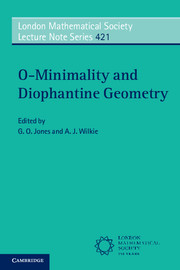Book contents
- Frontmatter
- Contents
- Preface
- 1 The Manin-Mumford Conjecture, an elliptic Curve, its Torsion Points & their Galois Orbits
- 2 Rational points on definable sets
- 3 Functional transcendence via o-minimality
- 4 Introduction to abelian varieties and the Ax–Lindemann–Weierstrass theorem
- 5 The André-Oort conjecture via o-minimality
- 6 Lectures on elimination theory for semialgebraic and subanalytic sets
- 7 Relative Manin-Mumford for abelian varieties
- 8 Improving the bound in the Pila-Wilkie theorem for curves
- 9 Ax-Schanuel and o-minimality
5 - The André-Oort conjecture via o-minimality
Published online by Cambridge University Press: 05 August 2015
- Frontmatter
- Contents
- Preface
- 1 The Manin-Mumford Conjecture, an elliptic Curve, its Torsion Points & their Galois Orbits
- 2 Rational points on definable sets
- 3 Functional transcendence via o-minimality
- 4 Introduction to abelian varieties and the Ax–Lindemann–Weierstrass theorem
- 5 The André-Oort conjecture via o-minimality
- 6 Lectures on elimination theory for semialgebraic and subanalytic sets
- 7 Relative Manin-Mumford for abelian varieties
- 8 Improving the bound in the Pila-Wilkie theorem for curves
- 9 Ax-Schanuel and o-minimality
Summary
Introduction
Shimura varieties are a distinguished class of algebraic varieties that parameterise important objects from linear algebra called Hodge structures. Often these Hodge structures correspond to families of so-called Abelian varieties.
Additional structure on a Shimura variety S arises through the existence of certain algebraic correspondences on S, i.e. subvarieties of S × S, called Hecke correspondences. We can think of these as one-to-many maps
T : S → S.
We endow S with a set of so-called special subvarieties, defined as the set of all connected components of Shimura subvarieties and the irreducible components of their images under Hecke correspondences. This is analogous to the case of Abelian varieties (respectively algebraic tori), where special subvarieties are the translates of Abelian subvarieties (respectively subtori) by torsion points. A key property of special subvarieties is that connected components of their intersections are themselves special subvarieties. Thus, any subvariety Y of S is contained in a smallest special subvariety. If this happens to be a connected component of S itself, then we say that Y is Hodge generic in S.
We refer to the special subvarieties of dimension zero as special points. Special subvarieties contain a Zariski (in fact, analytically) dense set of special points. The André-Oort conjecture predicts that this property characterises special subvarieties:
Conjecture 1.1 (André-Oort) Let S be a Shimura variety and let Σ be a set of special points contained in S. Every irreducible component of the Zariski closure of ∪s∊Σs in S is a special subvariety.
A connected component of S arises as a quotient Γ\D, where D is a certain type of complex manifold called a Hermitian symmetric domain, and Γ is a certain type of discrete subgroup of Hol(D)+ called a congruence subgroup. From now on, we will use S to denote this component.
By [10], §3, there exists a semi-algebraic fundamental domain F ⊂ D for the action of Γ. By [10], Theorem 1.2, when the uniformisation map
π : D → S
is restricted to F, one obtains a function definable in the o-minimal structure Ran,exp. Through these observations, the André-Oort conjecture becomes amenable to tools from o-minimality.
- Type
- Chapter
- Information
- O-Minimality and Diophantine Geometry , pp. 129 - 158Publisher: Cambridge University PressPrint publication year: 2015
- 3
- Cited by



